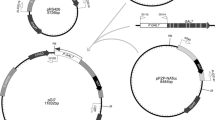Summary
Previous results showed that cell disintegration in the fungusPodospora anserina occured through the action of two proteases, enzymes whose messengers were normally latent during the extension stage of the thallus.
We selected three mutant strains in which the constitutive activity of the protease messengers was expressed by an arrest of growth early in development (10 to 30 hours after spore germination) and a reaction of cell disintegration, in the thallus, suppressible with β-phenyl pyruvic acid, a protease inhibitor.
The mutant character is recessive in one strain. In the case of the two strains in which the mutant trait is dominant, reversion studies have revealed that the deregulation resulted from the specific interaction between two genes and we have succeded in creating two non allelic incompatibility systems comparable to the non allelic gene interactions responsible for the incompatibility phenomena found between wild type races.
We know, on the whole, that 11 loci are involved in the regulation of the proteases: five were revealed as incompatibility loci and six were discovered from investigations on four self-lysing mutant strains. It is suspected that all these genes act at the post-transcriptionnal level of the synthesis of specific proteolytic enzymes. We propose that the products of two genes act as “repressors” to prevent the protease messengers from being constitutively translated and that the products of the nine remaining genes exert a positive control by inducing translation, at the appropriate time, through the action of effectors resulting from specific interloci cooperation.
Similar content being viewed by others
References
Bégueret, J.: L'incompatibilité cellulaire chez le champignonPodospora anserina: étude physiologique de la réaction. Thèse Univ. Bordeaux II (1973)
Bégueret, J., Bernet, J.: L'incompatibilité cellulaire chez le champignonPodospora anserina: déterminisme génétique et mécanisme physiologique de la réaction d'incompatibilité. Coll. Soc. Fr. Immuno. Paris, octobre 1972. Publi. INSERM (1973)
Bégueret, J., Bernet, J.: Protéolytic enzymes and protoplasmic incompatibility in the fungusPodospora anserina. Nature (Lond.) New Biol.243, 94–96 (1973)
Bégueret, J., Labarère, J.: L'auto-incompatibilité cellulaire chez le champignonPodospora anserina. Société Française Génétique (volume: la recombinaison bactérienne, hémotypologie et cytogénétique), 97–102 (1971)
Belcour, L., Bernet, J.: Sur la mise en évidence d'un gène dont la mutation supprime spécifiquement certaines manifestations d'incompatibilité chez lePodospora anserina. C. R. Acad. Sci. (Paris)269, 712–714 (1969)
Bernet, J.: Mode d'action des gènes de barrage et relation entre l'incompatibilité cellulaire et l'incompatibilité sexuelle chez lePodospora anserina. Ann. Sci. Nat. Bot.12, 611–768 (1966)
Bernet, J.: Systèmes d'incompatibilité chez lePodospora anserina. C. R. Acad. Sci. (Paris)265, 1536–1539 (1967)
Bernet, J.: Sur un cas de suppression de l'incompatibilité cellulaire chez le champignonPodospora anserina. C. R. Acad. Sci. (Paris)273, 120–122 (1971)
Bernet, J., Bégueret, J.: Sur les propriétés et la structure des facteurs d'incompatibilité chez lePodospora anserina. C. R. Acad. Sci. (Paris)266, 716–718 (1968)
Bernet, J., Bégueret, J., Labarère, J.: Incompatibility in the fungusPodospora anserina: are the mutations a bolishing the incomparibility reaction, ribosomal mutations? Molec. gen. Genet124, 35–50 (1973)
Bernet, J., Belcour, L.: Sur la possibilité de sélectionner des mutants des gènes d'incompatibilité chez lePodospora anserina et sur les propriétés des premiers allèles obtenus. C. R. Acad. Sci. (Paris)265, 1536–1539 (1967)
Boucherie, H.: Etude des relations entre les phénomènes d'incompatibilité et de différenciation des organcs reproducteurs femelles chez le champignonPodospora anserina. Thèse de Doctorat de 3o. cycle. Univ. Bordeaux II (1973)
Boucherie, H., Bégueret, J., Bernet, J.: Protoplasmic incompatibility inPodospora anserina: molecular events and relationship to the formation of the female organs. J. gen. Microbiol.92, 59–66 (1976)
Boucherie, H., Bernet, J.: Protoplasmic incompatibility and female organ formation inPodospora anserina: properties of mutations abolishing both processes. Molec. gen. Genet135, 163–174 (1974)
Esser, K.: An introduction toPodospora anserina. Neurospora Newsletters15, 27–30 (1969)
Labarère, J.: Propriétés d'un système d'incompatibilité chez le champignonPodospora anserina et intérêt de ce système pour l'étude de l'incompatibilité. C. R. Acad. Sci. (Paris) D.276, 1301 (1973)
Labarère, J., Bégueret, J., Bernet, J.: Incompatibility inPodospora anserina: comparative properties of the antagonistic cytoplasmic factors of a non allelic system. J. Bact.120, 854–860 (1974)
Author information
Authors and Affiliations
Additional information
Communicated by F. Gros
Rights and permissions
About this article
Cite this article
Delettre, Y.M., Bernet, J. Regulation of proteolytic enzymes inPodospora anserina: Selection and properties of self-lysing mutant strains. Molec. Gen. Genet. 144, 191–197 (1976). https://doi.org/10.1007/BF02428108
Received:
Issue Date:
DOI: https://doi.org/10.1007/BF02428108




